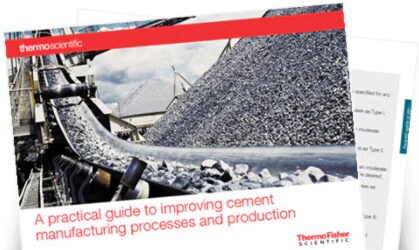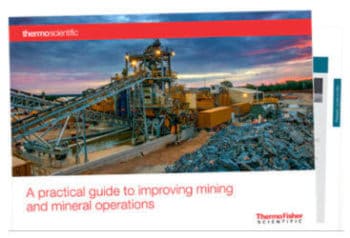Alternative Fuels (AFs) are being increasingly used in cement kilns to replace fossil fuels and contribute to a more environmentally compliant cement manufacturing process. However, these AFs need to be conditioned and validated for their suitability in kilns while meeting the regulatory emission norms. (See US EPA Cement Sector Information.) They can be liquids, solids, slurries of inorganic or organic nature and can represent complex chemistry to deal with.
X-Ray Fluorescence (XRF) is one of the most suited analytical techniques for the elemental analysis of these diverse materials before they are qualified for incineration in cement kilns. Analysis of toxic or heavy elements, undesirable elements, for cement quality control can be achieved easily using XRF with little or no sample preparation.
About Cement Production and Alternative Fuels
Cement kilns are high-temperature furnaces critical to cement production. The cement process starts by crushing and mixing raw materials like limestone, clay, and shale to form a raw meal. This meal is heated inside the kiln, causing chemical reactions that transform it into clinker. Clinker is cooled rapidly to maintain its quality. The cooled clinker is then ground into a fine powder and mixed with gypsum to enhance its properties. The resulting powdered cement is stored, packaged, and distributed for use.
According to the EPA, the “main source of air toxics emissions from a Portland cement plant is the kiln. Emissions originate from the burning of fuels and heating of feed materials. Air toxics are also emitted from the grinding, cooling, and materials handling steps in the manufacturing process. Pollutants regulated under this rule are particulate matter, organic HAP (hazardous air pollutants), metals through the control of particulate matter, mercury, acid gases, and dioxin/furan.”
Modern cement kilns often incorporate advanced technologies to improve energy efficiency and reduce emissions, such as the use of alternative fuels like biomass or waste materials. These advancements aim to make the cement manufacturing process more sustainable, economical, and environmentally friendly.
Alternative fuels can include solid waste fuels, petroleum coke (“petcoke”), paper waste, rubber residues, pulp sludge, used tires, battery cases, plastics residues, wood waste, domestic refuse, rice chaff, refuse derived fuel, nut shells, oil-bearing soils, and even sewage sludge. Liquid waste fuels are also used, and can consist of tar, chemical wastes, distillation residues, waste solvents, used oils, wax suspensions, petrochemical waste, asphalt slurry, paint waste, and oil sludge.
Biofuels, like biodiesel made from used cooking oil, can reduce greenhouse gas emissions, have a lower carbon footprint, and aid in waste management by utilizing organic waste materials.
However, alternative fuels, including biofuels, must be suitable for incineration.
Beware of Contaminants in Alternative Fuels
Using alternative fuels in cement kilns involves fuel preparation, co-firing or full substitution, combustion, and emission control. The alternatives are processed and optimized for combustion. They can be blended with traditional fuels or completely replace them. To comply with air quality regulations, cement kilns are equipped with emission control systems that capture pollutants.
It’s worth noting again that the use of alternative fuels in cement kilns requires careful selection, handling, and monitoring to ensure stable and efficient combustion while maintaining the desired product quality. Cement manufacturers work closely with experts and follow industry best practices to implement biofuel usage in a safe and effective manner. Many of those experts are utilizing laboratory-based technologies like EDXRF and WDXRF to analyze those materials.
XRF Analysis
X-ray fluorescence (XRF) analysis is a technology that utilizes the interaction between X-rays and matter. Atoms consist of a nucleus surrounded by electrons in shells, balancing the positive charge of the nucleus. When high-energy X-rays strike an atom, an electron in the inner shell is ejected, creating a vacancy. An electron from a higher shell then fills this vacancy, emitting secondary X-rays with an energy difference between the electron’s quantum states. Each element emits unique X-ray signals, forming an elemental fingerprint or spectrum during XRF analysis.
EDXRF (energy-dispersive XRF) enables quick and easy analysis of even irregular samples with little-to-no sample preparation. In EDXRF analysis, the characteristic X-rays of different elements present in a reading are separated into a complete fluorescence energy spectrum using either direct excitation (2D optics) or indirect excitation (3D optics). EDXRF technology is engineered to simultaneously process whole groups of elements for qualitative or quantitative analysis and can be used in portable and laboratory-based formats. As a result, EDXRF can accommodate samples of almost any shape and size.
An EDXRF spectrometer can provide major, minor, and trace element quantification across the broadest range of samples, including bulk solids, granules, loose or pressed powders, fused beads, thin films, pastes, and liquids.
WDXRF (wavelength-dispersive XRF), meanwhile, is the standard test method for a wide range of applications due to its outstanding sensitivity and high resolution. A WDXRF spectrometer can help meet demanding materials analysis requirements with qualitative and quantitative characterization of all types of conductive and non-conductive unknown samples.
Summary
Alternative fuels, including biofuels, can be combined with traditional fuels for better energy efficiency and to decrease reliance on fossil fuels. Their use aligns with environmental regulations and sustainability goals, allowing cement manufacturers to comply with emission reduction targets and showcase their commitment to sustainable practices.
The use of XRF spectrometry can help achieve toxic and heavy elements analysis in alternative fuels, bringing cement operators one step closer toward greener, more environmentally friendly, cement operations.


Leave a Reply